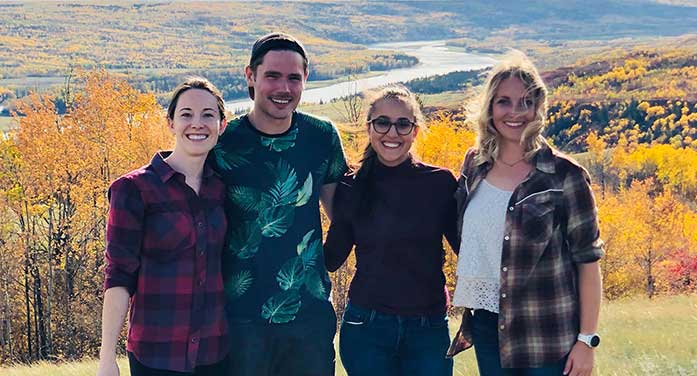Ponoka family doctor Greg Sawisky grew up in Kelowna, B.C., before heading to the University of Alberta for medical school. After a couple of shadowing opportunities in Fort McKay and Stettler, he threw himself into the Faculty of Medicine and Dentistry’s Rural Integrated Community Clerkship program and hasn’t looked back.
“There is something so wonderfully powerful about being a physician involved in true cradle-to-grave medicine,” Sawisky said about being a rural practitioner. “I get a chance to participate in the entire human experience, sometimes all during the one shift.”
Sawisky, who has been a preceptor and is now the clerkship co-ordinator for learners in Ponoka, Alta., said the best way to recruit rural generalists “is to enable medical students to work and live in rural environments during their foundational medical education.”
A former urbanite, Sawisky is somewhat of an anomaly when it comes to health professionals in Alberta’s rural and remote areas. According to Mark Prins, director of the Office of Rural and Regional Health, many rural physicians grew up in smaller communities. Others are relative newcomers to Canada who take up rural practice for various reasons. Still others were drawn to rural practice during training, inspired by a preceptor or seeing a need.
That need is great and there are gaps to be filled, Prins said.
In northern and rural Alberta, “there is great inequity and disparity in health-care services, delivery and outcome,” said Shirley Schipper, vice-dean of education in the Faculty of Medicine & Dentistry. In response, the faculty has sharpened its rural focus.
Prins agrees. A family physician from rural Alberta who worked for years in the Northwest Territories, he’s now rural and regional health director. He said medical education should reflect societal priorities. That means getting medical students out of the city. It means building enduring partnerships with communities where those students will live. Members of Prins’ team regularly travel to remote communities and meet with family doctors.
“It can take years of relationship-building before a community takes on a student,” he said. Without that foundation, he noted, none of the teaching initiatives within the faculty will take hold.

(From left) Second-year medical students Jinny Donovan, Jason Ching, Manisha Baradia and Julie Saby enjoy the scenic view in Peace River during their four-week rural placement in 2019. (Photo: Supplied)
But long before a medical student gets to a rural placement, it’s important to show much younger students possible career paths, said Schipper. There are many faculty initiatives aimed at reaching high school students in rural and Indigenous communities.
Every year, U of A medical students act as ambassadors to rural high schools, and last year did 25 school presentations. A handful of outreach events target children in elementary and junior high schools. For example, the Medical Students’ Association’s annual Virtual Science Fair gathers kids in grades 4 through 12 who wouldn’t otherwise be able to participate. The faculty participates in the annual U School program, which invites rural, underrepresented and Indigenous students to a week-long immersion experience on campus (or virtually, due to COVID-19).
To ensure medical students in the Rural Integrated Community Clerkship don’t feel alone or isolated, they are sent to placements in pairs, and Prins’s office checks on them regularly. There are also several physicians who head out to the communities every six to eight weeks to visit the students in person. The Rural Health Professions Action Plan rents accommodations for them, and preceptors are welcoming. To connect students more strongly to the community, each is expected to participate in volunteer work outside their medical work.
“Contributing time makes students feel invested in the community,” said Prins, adding that students participate in a graduated introduction to rural practice:
- In their first year, the Rural Shadowing Experience, funded through the Alberta Rural Health Professions Action Plan, pairs each medical student with one of more than 150 physicians across about 50 rural sites for a weekend of shadow learning.
- The Pre-Clinical Networked Medical Education program sends second-year students to central and northern Alberta towns for four weeks. Since 2010, 137 students have completed the program, Prins said.
- Third-year students in the Integrated Community Clerkship program can spend their clerkship in a rural community. There is also an option for students to complete their fourth year in Grande Prairie.
These in-house initiatives work, Prins said. Evidence shows that students are two and a half times as likely to practise rurally after the clerkship program. In annual surveys of participants, 86 per cent said they would do the clerkship program again and 92 per cent were more likely to consider a rural community as a future practice after completing the clerkship.
Schipper’s ambitious vision entails far more learners – 25 per cent of the class or more – doing the majority of their third- and fourth-year clerkships in rural and remote communities. An ultimate goal would be for interested students to have the chance to complete their entire medical training outside of an urban centre.
Prins would like to see more communities opening their doors for third- and fourth-year clerkships: “I’d like to see an increase in the number of specialty residents in post-grad education doing part of their training in a rural or remote setting.”
In the meantime, as more students learn about the rewards of a rural or remote career, they’ll picture themselves there, Sawisky said.
“As a rural generalist I am rewarded every day with the richness of interacting with my patients, and privileged to share in their lives.”
| By Sasha Roeder Mah
Sasha is a reporter with the University of Alberta’s Folio online magazine. The University of Alberta is a Troy Media Editorial Content Provider Partner.
The opinions expressed by our columnists and contributors are theirs alone and do not inherently or expressly reflect the views of our publication.
© Troy Media
Troy Media is an editorial content provider to media outlets and its own hosted community news outlets across Canada.


